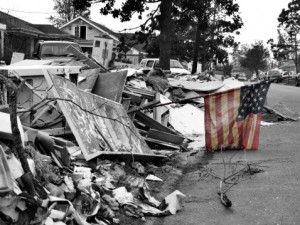Hurricane Katrina was one of the most devastating natural disasters to occur in the continental United States, and the effects of this disaster are felt to this day. Social workers played a vital role in the recovery efforts following Katrina, and important lessons gained from their experiences can aid social service providers in helping the public in the aftermath of future crises.
The long-term nature of mental health needs after disasters, such as Hurricane Katrina, continues to require attention. Research that emerged during the anniversaries of the storm has shown Katrina and its aftermath to be associated with posttraumatic stress, depression, anxiety, disruptive behavior, and somatic complaints in children and adolescents. Ten years after one of the most devastating storms in U.S. history, lessons can be learned from mental health interventions designed to help children and families cope with trauma.
In a recent issue of the social work journal Children & Schools, published by NASW Press, researchers reveal their findings from discussions with service providers who worked in the Classroom-Community Consultation (C3) program in the years following Hurricane Katrina. Their study tooks a retrospective look at C3, a school-based referral model established months after Hurricane Katrina. Developed by Project Fleur-de-lis (PFDL), the largest school-based mental health program in New Orleans, the C3 model brought school-based mental health professionals together with PFDL staff in the community to triage students who needed intensive services. Within a case study framework, this study describes the evolution, impact, and implications of C3 from the perspective of five former C3 participants. Participants shared how and why they became involved with C3, the consultation they received, how C3 helped them grow as practitioners and connected them with additional resources, and implications for linking community-based and school-based mental health services to be better prepared for any disaster.
The findings discuss participants’ Involvement with C3, including how they learned about C3 and decided to become involved, and how their involvement in C3 changed over time. The researchers further looked at the Impact of C3 on the participants, and their growth in the C3 program. Most importantly, the researchers sought to garner the participants’ insights into the effectiveness of C3 and how such programs might be improved.
The researchers found that there are three lessons to be learned from C3 about (1) how linking school-based and community-based services can be beneficial for the professionals and the youths served, (2) the difference between investing in people rather than programs, and (3) the importance of being flexible and responsive to the community’s needs. Linking school-based and community-based services is mutually beneficial for professionals in schools and professionals in community agencies; this could lead to improved outcomes for youths, as C3 participants shared. The isolation that the participants felt was likely compounded after Hurricane Katrina because school networks were not what they were before. Irrespective of a disaster or how long professionals have held their position, being alone in their position is often the nature of being a mental health service provider in a school. C3 provided a place for service providers to come together, have support, ask questions, and not feel alone. Service linkages can also provide community-based service providers the opportunity to work with youths in the environment where youths spend most of their days—at school. Gathering additional crucial information about the youths can lead to better outcomes and increase access to mental health services and beyond.
When starting C3, PFDL had the choice to invest in people or to invest in programs—PFDL decided to invest in people through C3 by enhancing the knowledge and capacity of the individual mental health service providers so that they could identify the needs of children and families and connect them with proper services. In fact, the decrease in referrals and attendance at the C3 meetings could reflect, in part, PFDL’s success in investing in the service providers.
Aligned with investing in the professionals, PFDL staff routinely elicit feedback from the participants, remaining flexible and responsive to their and the community’s changing needs. C3 participants specifically highlighted how they felt that the PFDL staff always had time for them and listened to them. This is done informally, as the participants described, and formally through surveys distributed by PFDL staff. Participants’ feedback led to the CEU events that provide a space to maintain community among the professionals. Besides revealing attendees’ appreciation and active engagement in learning, their comments also provide information on how PFDL can improve the CEU presentations and trainings. This valuable feedback continues to shape PFDL. For example, feedback on surveys provided ideas for promoting self-care among professionals to combat secondary traumatic stress, compassion fatigue, and vicarious trauma. PFDL has provided a variety of self-care resources at CEU events, as well as through its e-mail Listserv and social media, and facilitates self-care discussions and activities during trainings. Evolving according to needs that arise in the community has kept PFDL relevant.
The researchers concluded:
The long-term mental health effects after disasters continue to need attention. To respond most effectively and most compassionately, data are still required on the mental health needs of disaster survivors, who receives care, and if it made a difference. Anniversaries of Hurricane Katrina will continue to come and go, but being adequately prepared with the capacity to respond to other disasters and emergencies could help mitigate the impact of such traumas.




